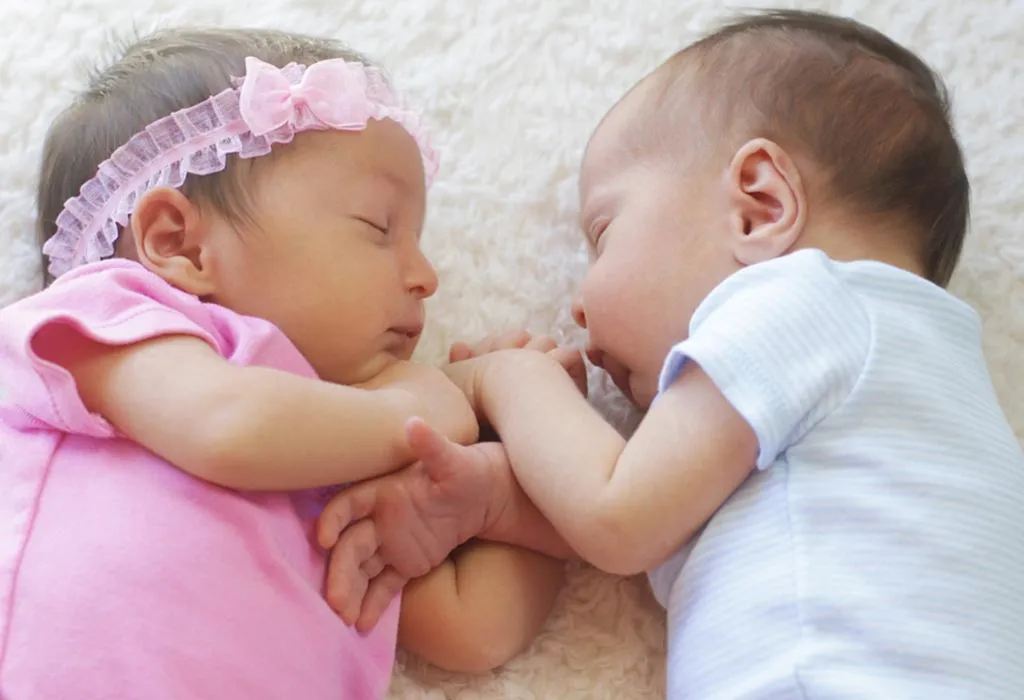Fraternal Twins – Things That Parents Should Know

Raising twins can be a double blessing for parents, but it also comes with double the challenges. While it can seem tough at times, having twins has many amazing aspects. Fraternal twins, or dizygotic twins, are the most common type. Unlike identical twins, fraternal twins do not share the same genes, leading to differences in appearance, personality, and developmental milestones. This genetic diversity results in many surprising facts about fraternal twins, from their genetic similarities to the factors that increase the likelihood of their occurrence. For parents, understanding these nuances is crucial for nurturing each child’s individuality while fostering a strong sibling bond. Here, you can find some interesting and surprising facts about fraternal twins.
What Are Fraternal Twins?

Doctors define fraternal twins as siblings who develop simultaneously in the womb but originate from two separate eggs fertilised by two different sperm cells during the same conception cycle. This results in twins who share, on average, 50% of their genetic material, similar to any siblings born at different times. Fraternal twins can be of the same sex or different sexes and may resemble each other as much as any siblings do, varying widely in appearance, temperament, and other characteristics (1).
How Common Are They?
Fraternal twins are more common than identical twins but still relatively rare in the general population. The frequency of fraternal twins varies depending on ethnic background, maternal age, fertility treatments, and family history. On average, fraternal twins occur in about 1 in every 80 pregnancies worldwide. However, this rate can be higher in certain populations with a higher incidence of multiple ovulation (releasing more than one egg during a single menstrual cycle).
Factors such as genetics, maternal age (women over 30 tend to release more than one egg per cycle more frequently), and assisted reproductive technologies (like fertility treatments) can also increase the likelihood of fraternal twins.
How Are Identical and Fraternal Twins Different?
You may now wonder how fraternal twins are different from identical twins. To start with, identical twins are born due to the fertilisation of one singular egg with a sperm, whereas fraternal twins are born due to the fertilisation of two sets of eggs.
Monozygotic twins (identical twins) share 100% of the genes, whereas dizygotic twins (non-identical twins) share only 50%. This is similar to the genetic familiarity between siblings born at different times (2).
It is common to have a fraternal twin set with one of each gender rather than the same gender.
For example, in 100 births, there will be at least two fraternal twins, making them more common than identical twins.
How Do Dizygotic Twins Fit?
Dizygotic twins are the scientific name given to fraternal twins. The term ‘Di’ signifies two, and ‘zygotes’ refers to fertilised eggs, a unique characteristic that sets them apart.
The fraternal twins have two different amniotic sacks in the womb and a separate placenta. This is medically called dichorionic-diamniotic (Di means two). The two different sacks ensure equal chances of survival for the twins (8).
How Are Fraternal Twins Formed?
In a fraternal twin pregnancy, the first step occurs when the same sperm fertilises two eggs or ova and produces two genetically different foetuses. They share only 50% of the DNA, making them siblings who could have been born years apart.
What Increases the Chances of Fraternal Twins?
Researchers have shown that having twins depends mainly on the mother’s genetic side, and if they include fraternal twins, then the chances of having them are higher.
Apart from this, many other factors help increase the chances of fraternal twins. Some of them are:-
- If the mother is over 30, the chances are higher. This is largely due to the hormone FSH, or follicle-stimulating hormone, which releases two eggs.
- The mother’s genetic history and occurrence of non-identical twins in the family.
- If there have been twins on the mother’s and father’s sides, the chances are even higher.
- Women who have a BMI over 30 are more likely to have twins than the ones with a healthier BMI. Extra fat leads to higher levels of oestrogen. Similarly, women taller than the average are more likely to have twins. A study indicated that, on average, women who were 164.8 cm tall were more likely to conceive twins than women with an average height of 161.8 cm.
- The number of earlier pregnancies and large families also increase the odds of having twins.
- There are more twins in certain parts of the world than in others. For instance, Africa has a higher number of women than other parts of the world (6).
- Breastfeeding women are more likely to have twins than women who don’t. One study found the rate of twins to be 11.4% amongst breastfeeding women as compared to non-breastfeeding women, for whom it was just 1.1%.
- One study found that women who eat a lot of dairy products are more likely to have twins.
- Fertility treatments that boost ovulation can raise the chances of having fraternal twins.
What Do Dizygotic Twins Look Like?
Do fraternal twins look alike? Yes and no. Because they share 50% DNA, they look similar, like any other brother or sister. How we look is entirely controlled by chromosomes, from how tall we are to the colour of our eyes, hair and so on, making them look as close to alike as possible. Your twins are also born at the same time, age, and rate, so it is normal for them to grow up together and look similar.
How Will You Know That You Are Pregnant With Non-Identical Twins?
A fraternal twin pregnancy can be something that you know because of intuition. Some women may even have dreams that they are pregnant with non-identical twins. You may even feel more nauseous than other pregnancies in the first trimester itself. High levels of intolerance for certain foods, smells, and textures like meat, seafood, and coffee can also be a sign. The most obvious one will be that you will look ‘large for dates’ from early on, which is a clear indicator of a twin pregnancy (7). Frequent urination is more magnified when you are having twins. Also, higher levels of hCG than a single pregnancy could be another confirming factor.
Development of Fraternal Twins
A fraternal twin pregnancy week-by-week can be broadly divided into early and later development.
1. Early Development
In the first eight weeks of fraternal twin pregnancy, each fertilised egg starts developing into hundreds of cells with layers attached to different sides of the womb. They have their own amniotic sac and start developing body parts and organs. By eight weeks, they have arms and legs that bend, their hearts are beating, and they start developing the nervous system.
By 12 weeks, they start kicking and stretching, and their fingernails and eyelids over their eyes start growing. By 16 weeks, they have unique fingerprints. They also begin peeing out the amniotic fluid that they have swallowed. By 20 weeks, they start getting hair.
2. Later Development
By 24 weeks, eyebrows start growing. The twins also have a complete set of tooth buds for the teeth to come in after birth. By 28 weeks, the twins can open eyelids, and layers of fat are building under their skin and smoothing out. They can suck on their fingers. By 32 weeks, the twins will be fully formed with arms, legs, and torsos and have a full head of hair. They are ready to be born in a couple of weeks.
What Are the Risks of Having Dizygotic Twins?
One must be aware of the many risks involved in a twin pregnancy. Some of them are:
- Low Birth Weight is sometimes a complication of having twins.
- Intrauterine Growth Restriction can occur, which slows down the rate at which your twins grow at 30 weeks. This is because the placenta cannot handle the growth of the twins.
- Pregnancy Induced Hypertension (PIH) is also higher during a twin pregnancy.
- The risk of diabetes, also known as Gestational Diabetes, is also higher.
- Miscarriage or demise of a twin during birth is also a potential risk.
- Chances of premature birth are also higher during twin pregnancies.
Surprising Facts About Non-Identical Twins
Some unique facts about fraternal twins you may not be aware of:
- They can be of a different gender or the same, i.e., you can have one of each gender or a set of boys or girls (5).
- They may not look alike since they only share 50% of the DNA and have different eye colour, stature, and hair colour.
- They will have different characteristics and will not behave similarly.
- Twins can run in the family, and a family with a history of twins is more likely to have twins, especially those dependent on the mother’s side (4).
- They can be conceived at different times and have different biological fathers. This phenomenon is known as superfetation (3).
- Fraternal Twinning rates vary across locations, with Central Africa having the highest and Asia and Latin America the lowest.
- They can be had due to fertility treatments as well.
- Being pregnant with twins can put additional demands on your pregnancy.
FAQs
1. Are there any health considerations specific to fraternal twins?
Fraternal twins may face increased risks associated with multiple births, such as premature birth, low birth weight, and complications during pregnancy and delivery. Parents must know these potential health issues and work closely with healthcare providers to monitor their twins’ development.
2. How can parents foster individuality in fraternal twins?
As parents, you have a unique opportunity to foster individuality in your fraternal twins. Since they are genetically no more similar than regular siblings, it’s important to encourage and celebrate each child’s unique qualities, interests, and talents. This not only helps nurture their individual identities but also promotes healthy self-esteem.
3. What are some strategies for balancing attention between non-identical twins?
Managing the needs of two infants or toddlers simultaneously can be challenging. Parents can use strategies such as alternating caregiving responsibilities, creating individual bonding time with each twin, and involving family members or caregivers to provide support.
Twins are rare, and every parent should be lucky if they have them. Enjoy the journey of parenthood and focus on keeping your infants healthy and happy.
References/Resources:
1. FRATERNAL TWINS; National Human Genome Research Institute; https://www.genome.gov/genetics-glossary/Fraternal-Twins
2. The Difference Between Identical and Fraternal Twins; American Academy of Pediatrics; https://www.healthychildren.org/English/family-life/family-dynamics/Pages/The-Difference-Between-Identical-and-Fraternal-Twins.aspx
3. Roellig. K, Menzies. B. R, Hildebrandt. T. B, Goeritz. F; The concept of superfetation: a critical review on a ‘myth’ in mammalian reproduction; PubMed; https://pubmed.ncbi.nlm.nih.gov/20394608/
4. 18 Fun Facts About Twins; Loma Linda University Center for Fertility & IVF; https://lomalindafertility.com/twins-facts/
5. About twins; Twins Research Australia; https://twins.org.au/twins-and-families/about-twins/
6. Facts about multiples; International Council of Multiple Birth Organisations; https://icombo.org/fun-facts/
7. Pregnant with twins; NHS; https://www.nhs.uk/pregnancy/finding-out/pregnant-with-twins/
8. Marquard. K, Moley. K; Multiple Gestations and Assisted Reproductive Technology; Avery’s Diseases of the Newborn; https://www.sciencedirect.com/sdfe/pdf/download/eid/3-s2.0-B9781437701340100071/first-page-pdf
Also Read:
Amazing Facts About Twins
How To Get Pregnant With Twins?
Potential Complications of Twin Pregnancy
Types of Twins in Pregnancy – Identical & Fraternal
Was This Article Helpful?
Parenting is a huge responsibility, for you as a caregiver, but also for us as a parenting content platform. We understand that and take our responsibility of creating credible content seriously. FirstCry Parenting articles are written and published only after extensive research using factually sound references to deliver quality content that is accurate, validated by experts, and completely reliable. To understand how we go about creating content that is credible, read our editorial policy here.























